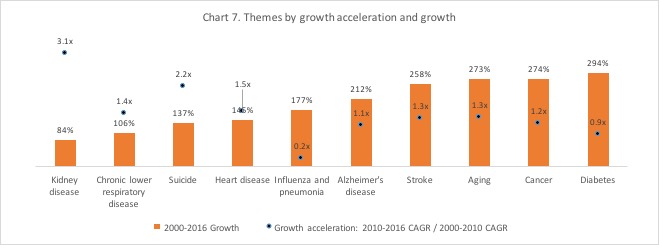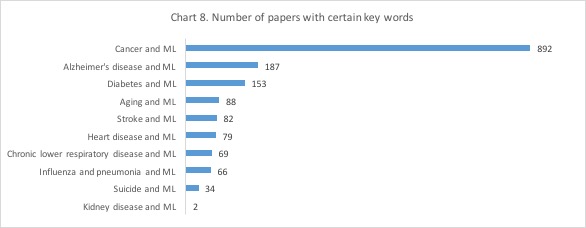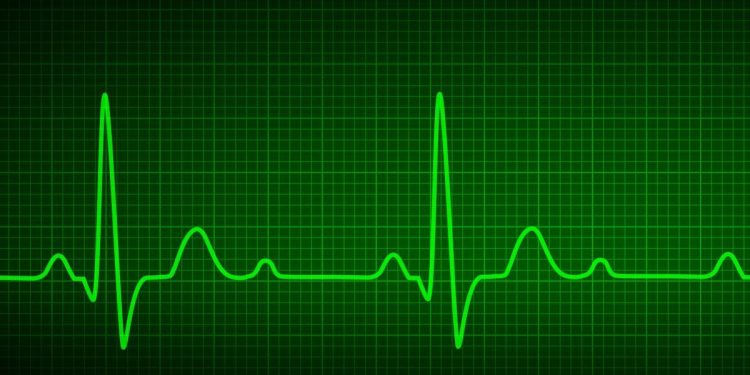American physician and surgeon William J. Mayo, one of the founders of the famed Mayo Clinic, stated, “The aim of medicine is to prevent disease and prolong life, the ideal of medicine is to eliminate the need of a physician.” Emerging applications of artificial intelligence (AI), as well as medical research trends, suggests that we are moving toward fulfilling medicine’s aim and achieving its ideal.
Health care organizations appear to be preparing themselves for the next technological step. For instance, in 2014 health care providers spent 4.2 percent of their revenues on IT, compared to a 3.3 percent cross-industry average. Penetration of electronic health care records grew from 40 percent in 2012 to 67 percent in 2017. With its wealth of smart machines, health care is expected to be among the fastest growing industries in terms of data generated. Cisco estimates a 2015-2020 CAGR (compound annual growth rate) of machine-to-machine connections in health care to be 30 percent, more than the expected 29 percent growth rate for connected cars.
The next big thing in health care is also anticipated by investors, who have increased their bets on the segment. Venture capital investment in cutting-edge, AI-driven medical technologies like computer vision, machine learning (ML), and robotics has skyrocketed from $30 million in 2012 to $892 million in 2016.
Medical research and machine learning
Studying the academic and funding dimensions of the medical AI ecosystem, we see that the movement towards Mayo’s vision is taking place. Prediction and prevention, wellness and rehabilitation, amelioration of aging, and technological augmentation of doctors are all noticeable themes.
June 5th: The AI Audit in NYC
Join us next week in NYC to engage with top executive leaders, delving into strategies for auditing AI models to ensure fairness, optimal performance, and ethical compliance across diverse organizations. Secure your attendance for this exclusive invite-only event.
Prediction and prevention are well-known concepts for health care professionals. Now they appear to be revitalized and reinforced by machine learning. A dive into PubMed databases demonstrates that the pace of research activity for ML-powered prediction and prevention is currently higher than the research activity associated with these concepts without involving ML.

AI health care startups working with predictive and preventive medicine are a new phenomenon that seems to embrace growing research. Out of 218 health care AI startups selected from an industry database, 54 were involved in predictive medicine, with 44 founded in 2010 or later.

Some companies, like Jvion and HBI Solutions, provide health care organizations with patient-level predictions and risk scores. Others, like Ocuvera, bring prevention to hospitals’ operations by, for example, by identifying a patient’s proclivity to fall and helping to avoid the accident.
Activity in the wellness segment of the health care value chain also reflects growing interest in the preventive aspect of medicine. Wellness appears to be the fastest-growing segment among the core segments of the health care value chain.

Researchers’ attention to the wellness segment is matched by entrepreneurs’ interest. Out of 218 AI health care startups, 21 develop wellness applications.

Startup funding data suggests that younger startups tend to work with wellness applications. About 95 percent of AI-powered wellness startups were founded in 2010 or later, compared with 57 percent of those tackling surgery-related issues.

Wellness applications may use almost unlimited data from healthy populations, the collection of which is accelerated by new devices entering the market. The more data from healthy patients is available, the more insight one can get. Traditional health care uses data that is limited by the number of cases and more severe sampling requirements.
Prevention and prediction segments start from research into cells and genetics, aiming to eliminate the underlying causes of dangerous diseases. Machine learning drives these research topics as well.

Founding data for AI startups helps to identify the uptick in launching startups working with cell and genetic research. For example, notable companies such as Human Longevity, BenevolentAI, Recursion Pharmaceuticals, and at least seven others were launched between 2010 and 2017.
Following Mayo’s vision, health care researchers and founders try to make life longer by battling aging and making rehabilitation smoother. Medical research on aging is growing rapidly, compared with research on the leading causes of death in the U.S. It is also one of the fastest accelerating research area in the past six years.

Not being a disease in the traditional sense, aging is an excellent target for tech disruption, with no critical state (i.e., the fast deterioration of a patient) and developing across the whole lifespan. Aging research may benefit from lots of data collected during a patient’s life.
Already amassed data and evolving data collection technologies, combined with machine learning, contribute to fighting aging. For instance, this technology can check if senescence acceleration is taking place and estimate biological age more precisely. Then relevant treatment options can be selected. BioageLabs and Insilico Medicine use machine learning to discover anti-aging drugs.
Rehabilitation is experiencing a growing research interest as well. It also benefits from AI as it requires long-term commitment, repetitive actions, and a continuous feedback loop. Twelve startups are moving the field of rehabilitation forward by, for instance, working with brain dysfunction rehabilitation like Intendu or helping joint replacement patients like Peerwell.
Helping doctors, not replacing them
The examples given above suggest that tech is moving medicine toward preventing diseases from happening. This can be done by tweaking genes, detecting early signs of diseases, and altering human behavior for health benefits. Currently AI tech penetrates just a part of the list of dangerous diseases.

Perhaps at some point, all diseases will be preventable and there will be no need for a physician. But can tech eliminate physicians before it eliminates diseases by replacing human doctors with robots and algorithms? Our observation suggests that this goal is not a heavy area of interest. Instead, AI-powered health tech looks to assist physicians and make them more accessible for patients.
Studying 35 companies that employ computer vision in health care, one may conclude, that their primary approach is to augment professionals, rather than to replace them. For example, BayLabs “develops technology to simplify the process of recording, editing and sharing of video,” while Mindshare Medical aims “to empower clinicians and health care providers” by utilizing medical imaging. Oxford Heartbeat “helps clinicians accurately plan and rehearse stent placements inside blood vessels.”
Telemedicine is also empowering health care professionals rather than replacing them. In a world where 400 million people do not have access to basic health care services, telemedicine is a viable option to keep doctors busy, even after efficiency grows manifold and demand in well-off regions starts decreasing. Out of 218 companies, 39 are in one way or another providing telemedicine technologies. Some help patients to navigate medical knowledge and make a preliminary diagnosis (Babylon, YourMD), while others give doctors unprecedented monitoring tools (Sentrian, AiCure) and provide valuable health-related information and advice (ZoiHealth, Flo). Medical research in telemedicine is also growing rapidly, rocketing from 317 articles in 2010 to 845 in 2016.
Our inquiry suggests that the vision of medicine coined by Mayo is closer to life then we think, thanks to AI. Cognitive technologies fit nicely with the popular research themes explored above. Moreover, at the current stage, where diseases are not eliminated entirely, tech empowers rather than displaces health professionals. Therefore, we expect to see more exciting AI health tech to emerge and suggest entrepreneurs consider opportunities in this space.
Notes on data collection: Trends on research activity are derived from searching titles and abstracts at PubMed. Data on AI health tech companies is from a keyword search and manual selection at Pitchbook. Flint Capital is an investor in Flo, an AI-powered period and ovulation tracker referred to in this article.


